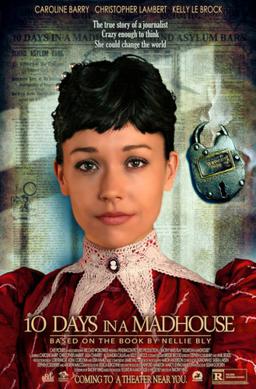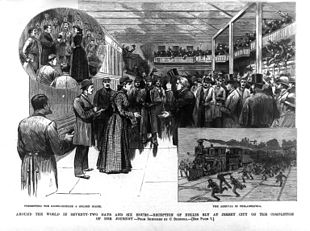
Around the World in Eighty Days is an adventure novel by the French writer Jules Verne, first published in French in 1872. In the story, Phileas Fogg of London and his newly employed French valet Passepartout attempt to circumnavigate the world in 80 days on a wager of £20,000 set by his friends at the Reform Club. It is one of Verne's most acclaimed works.

Elizabeth Cochrane Seaman, better known by her pen name Nellie Bly, was an American journalist, who was widely known for her record-breaking trip around the world in 72 days in emulation of Jules Verne's fictional character Phileas Fogg, and an exposé in which she worked undercover to report on a mental institution from within. She was a pioneer in her field and launched a new kind of investigative journalism.

George Francis Train was an American entrepreneur who organized the clipper ship line that sailed around Cape Horn to San Francisco; he also organized the Union Pacific Railroad and the Credit Mobilier in the United States in 1864 to construct the eastern portion of the Transcontinental Railroad, and a horse tramway company in England while there during the American Civil War.

Aouda, a character in Around the World in Eighty Days by Jules Verne, is an Indian princess accompanied by Phileas Fogg and Passepartout. The daughter of a Bombay Parsi merchant, she was married against her will to the old raja of Bundelkhand. At the death of her husband, she is about to be sacrificed by her husband's relatives and other people of their society as a sati at her husband's funeral pyre. Upon learning the circumstances of the sati and how this is all against Aouda's will, Fogg and company intervene and rescue her.

Around the World in 80 Days is a 2004 American action adventure comedy film based on Jules Verne's 1873 novel of the same name and remake of the movie of the same name of 1956. It stars Jackie Chan, Steve Coogan and Cécile de France. The film is set in the nineteenth century and centers on Phileas Fogg (Coogan), here reimagined as an eccentric inventor, and his efforts to circumnavigate the globe in 80 days. During the trip, he is accompanied by his Chinese valet, Passepartout (Chan). For comedic reasons, the film intentionally deviated wildly from the novel and included a number of anachronistic elements. With production costs of about $110 million and estimated marketing costs of $30 million, it earned $24 million at the U.S. box office and $48 million worldwide, making it a box office failure. It also received generally unfavorable reviews from critics, mainly for lacking similarities to the original book.

Phileas Fogg is the protagonist in the 1872 Jules Verne novel Around the World in Eighty Days. Inspirations for the character were the American entrepreneur George Francis Train and American writer and adventurer William Perry Fogg.

Around the World in 80 Days with Michael Palin is a 7-part BBC television travel series first broadcast on BBC1 in 1989. It was presented by comedian and actor Michael Palin. The show was inspired by Jules Verne's classic 1873 novel Around the World in Eighty Days, in which a character named Phileas Fogg accepts a wager to circumnavigate the globe in eighty days or less.

Jean Passepartout is a fictional character in Jules Verne's novel Around the World in Eighty Days, published in 1873. He is the French valet of the novel's English main character, Phileas Fogg. His surname translates literally to "goes everywhere", but “passepartout” is also an idiom meaning "skeleton key" in French. It can also be understood as a play on the English word passport—or its French equivalent passeport.

The Other Log of Phileas Fogg is a science fiction novel written by American author Philip José Farmer in 1973. Reviving the Phileas Fogg character created by Jules Verne, the novel has also been classified as steampunk and a parallel novel. It was originally published by DAW Books and later reprinted in 1979 by Hamlyn and again in 1982 by Tor Books. Tor has subsequently reissued the novel in 1988 and 1993.

Ten Days in a Mad-House is a book by American journalist Nellie Bly. It was initially published as a series of articles for the New York World. Bly later compiled the articles into a book, being published by Norman Munro in New York City in 1887.

Around the World in 80 Days is a British travel documentary series made to support the annual BBC Children in Need charity appeal in 2009. It sees twelve celebrities attempt to circumnavigate the globe in eighty days without using air transport, recreating the journey of Phileas Fogg and Michael Palin. Like Fogg and Palin, the journey begins and ends at the Reform Club in London. It was first shown on BBC One and BBC HD in October and November 2009.

Elizabeth Bisland Wetmore was an American journalist and author, perhaps now best known for her 1889–1890 race around the world against Nellie Bly, which drew worldwide attention. The majority of her writings were literary works. She published all of her works as Elizabeth Bisland.
Around the World in Eighty Days is an animated television series that lasted one season of 16 episodes, broadcast during the 1972–1973 season by NBC. It was the first Australian-produced cartoon to be shown on American network television. Leif Gram directed all 16 episodes, and the stories were loosely adapted by Chester "Chet" Stover from the 1873 novel by Jules Verne.

Journey Through the Impossible is an 1882 fantasy play written by Jules Verne, with the collaboration of Adolphe d'Ennery. A stage spectacular in the féerie tradition, the play follows the adventures of a young man who, with the help of a magic potion and a varied assortment of friends and advisers, makes impossible voyages to the center of the Earth, the bottom of the sea, and a distant planet. The play is deeply influenced by Verne's own Voyages Extraordinaires series and includes characters and themes from some of his most famous novels, including Twenty Thousand Leagues Under the Sea, Journey to the Center of the Earth, and From the Earth to the Moon.

A Boy Scout Around the World is a travel description published in October 1928 and written by Danish Boy Scout and later actor Palle Huld at the age of 15, following his travel around the world in spring 1928.

10 Days in a Madhouse is a 2015 American biographical film about undercover journalist Nellie Bly, a reporter for Joseph Pulitzer's New York World who had herself committed to the Women's Lunatic Asylum on Blackwell's Island to write an exposé on abuses in the institution. The production was written and directed by Timothy Hines with consultation from one of Bly's modern biographers, Brooke Kroeger. The film draws from Bly's book, Ten Days in a Mad-House, which led to significant reforms in the treatment of mental health patients. The cast includes Caroline Barry, Christopher Lambert, Kelly Le Brock, Julia Chantrey and Alexandra Callas.
This is a list of the fastest circumnavigation, made by a person or team, excluding orbits of Earth from spacecraft.
The Adventures of Nellie Bly is a 1981 American made-for-television drama film starring Linda Purl as 19th century journalist Nellie Bly and human rights crusader. The film was directed by Henning Schellerup. It was filmed in 1979 and aired on NBC June 11, 1981. The film was also known as The Amazing Nellie Bly.

Mount Repose is a historic mansion in Pine Ridge, Adams County near Natchez, Mississippi, USA. Mount Repose was one of the girlhood homes of Elizabeth Bisland, the "Cosmopolitan" magazine correspondent who raced Nellie Bly, the reporter for the "World" newspaper, around the world in 1889 - 1890.
Brooke Kroeger is a journalist, writer, and professor emerita at New York University. She has written books on Nellie Bly, Fannie Hurst, and most recently a 2023 book on women in journalism.



















